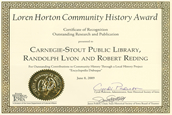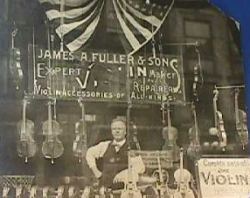Encyclopedia Dubuque
"Encyclopedia Dubuque is the online authority for all things Dubuque, written by the people who know the city best.”
Marshall Cohen—researcher and producer, CNN
Affiliated with the Local History Network of the State Historical Society of Iowa, and the Iowa Museum Association.
VIOLINS: Difference between revisions
No edit summary |
No edit summary |
||
| (2 intermediate revisions by the same user not shown) | |||
| Line 3: | Line 3: | ||
His instruments, accepted nationally in music schools and by professional musicians internationally, were made of seasoned wood salvaged from old furniture Fuller purchased in second-hand stores. The wood from two bedside boards, purchased for one dollar, was sufficient for eight violins. Fuller also repaired violins and other musical instruments. He later moved to Davenport. | His instruments, accepted nationally in music schools and by professional musicians internationally, were made of seasoned wood salvaged from old furniture Fuller purchased in second-hand stores. The wood from two bedside boards, purchased for one dollar, was sufficient for eight violins. Fuller also repaired violins and other musical instruments. He later moved to Davenport. | ||
[[File:violin1.jpg|250px|thumb|left|Violins were carved within patterns like these. Photo courtesy: Musical Instrument Museum. Phoenix, Arizona]] | |||
[[File:violin2.jpg|250px|thumb|right|Different stages of the violin's neck. Photo courtesy: Musical Instrument Museum. Phoenix, Arizona]] | |||
[[File:violin3.jpg|250px|thumb|left|Parts before assembly and staining. Photo courtesy: Musical Instrument Museum. Phoenix, Arizona]] | |||
[[File:violin3.jpg|250px|thumb|right|Collection of materials used to stain the wood. Photo courtesy: Musical Instrument Museum. Phoenix, Arizona]] | |||
--- | --- | ||
Latest revision as of 03:17, 23 February 2015
VIOLINS. Violins, patterned after the famed Strativarius and Guarnarius, were manufactured in Dubuque from 1908 to 1926 by James Fuller who operated a shop at 17th and Clay STREETS.
His instruments, accepted nationally in music schools and by professional musicians internationally, were made of seasoned wood salvaged from old furniture Fuller purchased in second-hand stores. The wood from two bedside boards, purchased for one dollar, was sufficient for eight violins. Fuller also repaired violins and other musical instruments. He later moved to Davenport.
---
Source:
Dilworth, John. The Brompton’s Book of Violin & Bow Makers. Online: http://www.amati.com/maker/fuller-james-a.html






